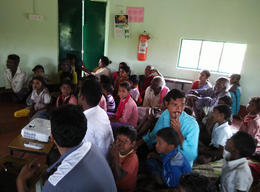An inclusive learning environment
The vision of the sanctuary schools is to create a culturally responsive, inclusive and contextually relevant learning environment for the tribal communities; that affirms their knowledge and ways of life while also building skills for participating meaningfully in today’s society. The tribal communities were knowledge holders and possessed a large amount of indigenous knowledge about the local forests and intuitively understood the connection between the local ecology and their life. However, with the mainstreaming of tribal communities – through education, development programs and more recently, the media – there has come a growing awareness in the community to learn to read and write and get education.
When the schools began as non-formal learning centres over 15 years ago in these remote tribal communities, we wondered what kind of education would make sense in this context. Will a formal school affirm their identity and their culture or will it make them disenfranchised within their world? How will we find an adult who will work with sensitivity to their context? These were questions that were in the forefront even as efforts began to set up non-formal learning centres in five villages.
Our guiding principles behind the schools are:
-
A learning environment without fear or reward where each student and teacher leanrs and grows according to their natural skills and abilities
-
Developing a responsive, relevant, engaging curriculum that valued their knowledge, lived experiences and traditional skills
-
Working with the community to help them understand the processes and demands of formal schooling
The schools are modeled along the philosophy of J Krishnamurti and the teachers were trained in the same ethos as that of other Krishnamurti Schools – one of freedom where learning happens without hierarchies.
Community ownership of the schools
Community involvement is a cornerstone of our school. It was also clear from the get go that for the school to be sustainable the community needed to ‘own’ the school and support the operations.The community made available the land for the school and the school infrastructure was developed with donations from different donors. These are maintained by the community and the community members also interact with students to share their knowledge of the forest.
This is our school
With the emphasis on universalization of primary education, there was a massive enrolment drive by the government to enrol the students from these villages into the government primary schools. The community owned up to their own school in their midst and communicated with the education administration that they would prefer that their children complete their basic education in their tribal school. “These schools have shown us the way to Baireddipalli (the nearest and biggest town); we will not leave this school. We will send our children to the government schools after they finish their schooling here”, Duggeppa, the elder from the Kalligutta village represented to the Mandal Education Officer.
“When the schools started, the children went and hid behind the bushes”, reminisces Krishnamurti, the first field co-ordinator of the program. “Now, the moment they see a teacher, they come running to the school”. “There is courage now in the children and us as adults. We are able to stand up and speak for ourselves, there is a confidence that we can do something”, says Subbarayappa, who was one of the architects of the school in the Mugilupodalarevu village.

